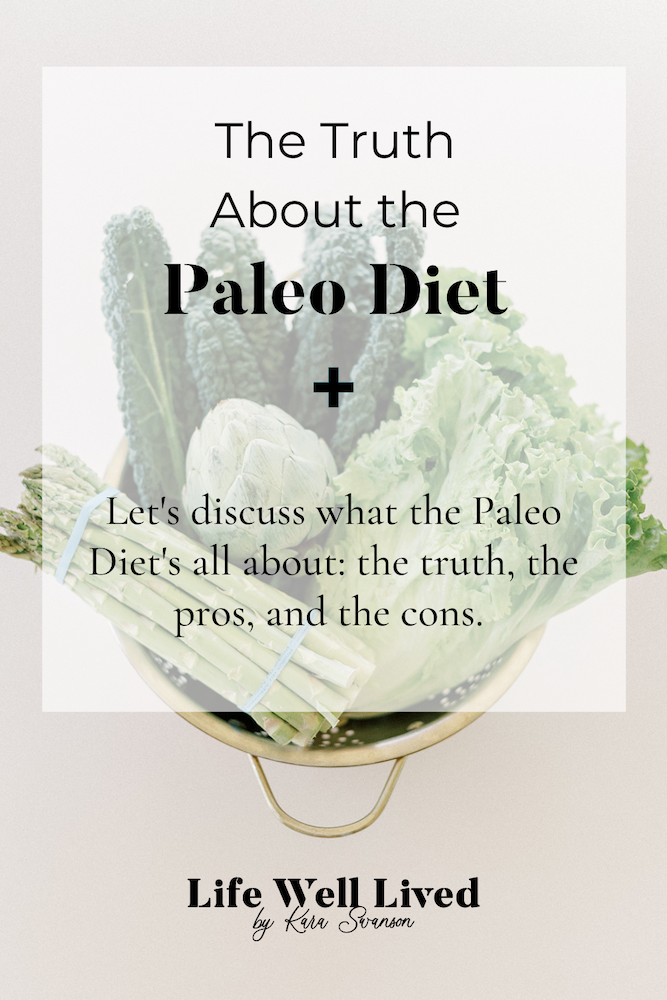The Truth About the Paleo Diet
Today, it seems there’s Paleo-everything: paleo-cereal, Paleo-ice cream, I think there’s even Paleo-toilet paper!
(Okay, I made the last one up, but it wouldn’t surprise me.)
The Paleo Diet sometimes called the caveman diet, is a diet that supposedly mimics the way people ate during the Paleolithic era. It’s supposed to promote longevity and help you lose weight.
We can both agree that adding more unprocessed foods to our diet is a good thing. But what the diet doesn’t address is that most people didn’t live past the age of 40 during this time. In fact, most children died before the age of 15.
So it makes you wonder: Why are we so obsessed with being like the Paleolithic people?
Today, I want to discuss the truth about the Paleo Diet, plus the pros and cons.
What does the Paleo Diet involve?
Depending upon who you talk to, what’s included or excluded may vary. But a typical paleo diet includes lean meats (grass-fed or wild game as much as possible), fish, fruits, vegetables, nuts, and seeds. The types of foods people lived on during hunter-gatherer days before farming came into the picture.
Paleo Diet OK list:
Lean meat (chicken, turkey, pork, lean beef, buffalo, and wild game)
Fish
Seafood
Fresh fruit
Nonstarchy vegetables (lettuce, asparagus, green beans, broccoli, cabbage, Brussels sprouts, cauliflower, and spinach)
Nuts (almonds, walnuts, cashews, pecans, and pistachios)
Seeds
Eggs
Plant-based oils (olive, walnut, grapeseed, and coconut oil)
It limits dairy products, legumes, and grains: foods that emerged as a result of farming technology.
Paleo Diet not OK list:
Grains (oats, wheat, barley, and rice)
Starchy vegetables (potatoes and corn)
Legumes or beans
Dairy products
High-fat meats (salami, bologna, pepperoni, hot dogs, ground meat, rib roast, and ribs)
Sugars
Processed foods or trans fats, (doughnuts, french fries, fruit snacks, or macaroni and cheese)
Salty foods (crackers, chips, pretzels, and other added-salt foods)
Paleo Diet pros
Now that we’ve covered what the Paleo Diet is, what it includes, and what it excludes, let’s talk about the pros and cons of the diet. And let’s talk about the pros first.
Paleo Diet Pro number 1:
The Paleo Diet has some redeeming qualities. We could all stand to consume more fruits and vegetables.
Pro number 2:
In addition to encouraging you to consume more fruits and veggies, the paleo diet encourages you to cut back on processed foods.
I strongly support the idea of swapping your pre-packaged snacks and fast food for more veggies.
Paleo Diet cons
Paleo Diet Con number 1:
The main problem with any diet is just that: it’s a diet. I’ve said it before: diets don’t work because they’re not sustainable.
Paleo Diet Con number 2:
Beyond that, the Paleo diet strongly discourages you from eating whole grains and legumes, two wonderful sources of fiber, vitamins, and other key nutrients our bodies need.
Paleo Diet Con number 3:
The Paleo Diet can also be expensive. Grass-fed meat and wild game can be expensive.
Paleo Diet Con number 4:
It also encourages you to consume large amounts of red meat, a known carcinogen. It can also increase cholesterol levels which lead to heart disease, the leading cause of death in the U.S.
Should you try the Paleo Diet?
A paleo diet may help you lose weight. And it could also help you eliminate some processed foods from your diet. However, it’s still a diet and doesn’t address the root cause of the problem: your habits. No one stays on a diet forever. Eventually, the diet ends and you’ll return to your old ways of eating.
Instead of beginning another fad diet, focus on changing your mind and implementing habits that will provide sustainable results.
And when you’re ready for some help, join me in the Living Well Membership where you’ll learn simple strategies to reach your fat loss goal and hold on to them without needing to diet!


